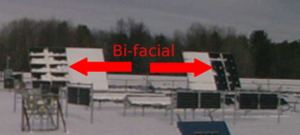
Bifacial photovoltaic dual-axis tracker systems have the potential to out-perform other module/mounting configurations at high latitudes, where the reflectivity of snow in winter boosts bifacial performance and the low solar angle-of-incidence favors dual-axis tracking. Two years of empirical data from dual-axis experimental systems in Vermont support this assertion, demonstrating that bifacial modules on a dual-axis tracker produced 14 percent more electricity in a year than their monofacial counterparts and as much as 40 percent during the peak winter months. These bifacial gains are in addition to the estimated 35-40 percent energy gains of a dual-axis tracker relative to a fixed-tilt system. Such findings suggest that bifacial two-axis tracker systems could be economically attractive in northern latitudes, with high-efficiency modules compensating for the trackers' installation and maintenance costs, and future design improvements enabling further performance gains.
See also[edit | edit source]
- Details on PV performance monitoring by R. Andrews. PV Performance Modeling: Assessing Variability, Uncertainty and Sensitivity. Solar Professional Issue 8.5, Sep/Oct 2015.
- "The 10 Snowiest Places on the Planet" by the Mother Nature Network.
- A Review of the Effects of Haze on Solar Photovoltaic Performance
Related Pages[edit | edit source]
- The Impact of Snow Losses on Solar Photovoltaic Systems in North America in the Future
- Snow Losses for Photovoltaic Systems: Validating the Marion and Townsend Models
- Differences in Snow Shedding in Photovoltaic Systems with Framed and Frameless Modules
- Impact of Snow and Ground Interference on Photovoltaic Electric System Performance
- Image Analysis Method for Quantifying Snow Losses on PV Systems
- Effects of snow on photovoltaic performance
- Open Solar Outdoors Test Field
- Outdoor data acquisition
- Queen's Innovation Park Test Site
- Solar resource measurement for PV applications
- Prediction of energy effects on photovoltaic systems due to snowfall events
- A new method to determine the effects of hydrodynamic surface coatings on the snow shedding effectiveness of solar photovoltaic modules
- Monofacial vs bifacial solar photovoltaic systems in snowy environments





